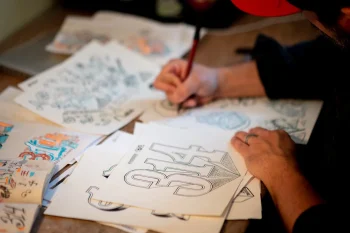Game On
With dozens of studios, courses and events, St. Louis is becoming the nation’s next video game development hot spot.
Matt Raithel was a gamer, right from the jump.
“When I was six, Nintendo was this on-fire, crazy toy of the year. When I got it – and this was the 1980s – you didn’t just plug it in. You had to practically take apart your television set,” he recalls. “Once it finally got connected and I flipped the thing on, it was like…intoxication. I played for maybe six hours that day.
“I remember telling my friends when they came over that this is what I was going to do when I grew up.”
Unlike so many other children’s early career fantasies, Raithel’s dream actually came true. Today, he’s the owner and studio director of Maryland Heights-based Graphite Lab, which creates in-house and branded games (including “Transformers,” “My Little Pony” and “Ben 10”) for all platforms. Its original flagship game “Hive Jump,” a retro-inspired game with “Metroid” flavor, recently became available on Nintendo Switch and Xbox One.
Graphite Lab joins peer companies Pixel Press, Volcano Bean, Terrifying Jellyfish and other creators in turning St. Louis into a burgeoning hub of game development and innovation.
The region’s video game revolution has been a long time coming, with many St. Louis development shops emerging from forays in programming, art or other industries. Some developers have spent the past decade or more pursuing gaming ideas as side projects or hobbies, while others set out immediately to engineer the games they’d always wanted. No matter how they got their start, the dozens of local game startups and community contributors today are positioning St. Louis as one of the country’s new centers for the industry.
It’s something that still takes people by surprise.
“When you’re talking about startups, it’s common that everyone defaults to California,” says Robin Rath, CEO and co-founder of Pixel Press, which is housed downtown. “It’s funny when we hear kids say, ‘Hey, do you live in San Francisco?’ and I say, ‘No, I’m in St. Louis, 10 miles from your school.’”
A Resourceful Community
In the past, St. Louis might have seemed like an odd choice for game development; many tech companies had been concentrated on the coasts because the proximity to talent, high-dollar funding and big brands was imperative. But now thanks to the internet and social media, developers can collaborate with each other and communicate with their customers from right here in the Midwest, giving indie game makers a rich opportunity to build a fan base over time. Moreover, St. Louis’s comparatively low cost of living, growing number of investors, and innovation communities that support entrepreneurs and knowledge workers make it easier to put more capital and energy into development rather than into location.
“From a startup perspective, whether it be access to capital, mentorship, legal [support] – all those things are here,” Rath says.
In St. Louis, that access isn’t limited solely to established companies. The local game development community is a sprawling ecosystem that welcomes creators of all levels through meetups, digital communities, hackathons, festivals, game dev camps, mentorship and more.
“I think St Louis is a really special place for making games because it’s such a diverse crowd of people making them. There’s everything from hobbyists to larger scale companies, but they’re all making something different and they all do it in a different way,” says Mary McKenzie, managing partner of the Metro East studio Volcano Bean, which produces mobile games “Where’s My Goblin?” “Sleepy Kraken” and “BattleCakes.”
During St. Louis Global Game Jam, gamers and prospective developers gather in person and online to design and build a game within 48 hours. The event, held annually at University of Missouri – St. Louis, typically ranks among the top three largest in the nation and top ten largest in the world.
The Game Jam is championed by the St. Louis Game Developer Co-Op, an essential resource for deepening industry knowledge and expanding professional networks. With meetups, workshops, affinity groups, demos and more, the Co-Op gives St. Louis developers plenty of opportunities to interact.
“They’re just super-great for finding people,” says TJ Hughes, an independent, self-taught game developer and 3-D artist who creates games as Terrifying Jellyfish. “No matter what you need – music, programming, someone who makes really weird, specific art – the Co-Op is probably the place where you can find that.”
Hughes cites familiar hotspots of creativity like the Cortex Innovation Community and its Venture Café as local places buzzing with new ideas and innovation, but he also says he finds inspiration in the city’s underground art scene, especially in the Cherokee Street area.
That influence can be seen in the Terryifying Jellyfish game “Nour,” in which users play with food in unconventional ways. Pancakes, sprinkles, boba balls and sushi rain from the sky and bounce around in a 3-D environment, serving up the opportunity to toy with texture and composition. In this game, there’s no end goal or boss level — it’s just fun for fun’s sake.
“It’s not about having an objective, it’s not about doing something right or high-stakes things,” Hughes insists. “It’s more about relaxing and really taking in the stimulus just at base level.”
Other St. Louis video games get physical in real life. “Bloxels,” from Rath’s Pixel Press, uses a board with plastic pegs to map out game levels and characters before animating them through a mobile app. Players then can continue to customize their games and share them with others.
Thanks to a partnership with Mattel, Pixel Press has bolstered the manufacturing and distribution of “Bloxels” in the retail world, while a partnership with Disney recently led to the creation of a “Star Wars” version of the product, which lets users play pre-made missions or create their own levels with familiar locations and characters.
“I was definitely a ‘Star Wars’ kid,” Rath says. “There’s something about the lore and the storytelling — just everything about it was something that was part of our childhood and what our company is.”
Planning for the Future
Enticing the next generation of local developers and gamers is something many St. Louis studios are working on. Gaming is considered a high-growth industry, and local experts are equipping students and enthusiasts of all ages for that future.
As a game development professor at Maryville University, Raithel is seeing enthusiasm for the industry mount.
“Even with a young program, I’ve seen students really leapfrog into some really incredible success. Usually that’s because of their own motivation and excitement to try something new,” he says. “A year ago, I asked them to pursue an interest in VR (virtual reality) – just threw that out there to see how they’d tackle it. What they came back with was not just a working VR program, but six working VR games that were strung together. That was a pretty mind-blowing moment for me.”
Pixel Press is looking to hook even younger gamers. Early on, the company discovered that Bloxels was being used in elementary- and middle-school classrooms to help students with skills like critical thinking and storytelling, which led Rath’s team to develop lesson plans and activities for students. A few years ago, the company introduced a new classroom-specific version called “Bloxels EDU.”
“It really focuses on ways for teachers to not only use this in the classroom, but also allow students to work together collaboratively, to develop contacts through this interactive storytelling platform that manifests itself as video games,” Rath says.
Something these and other game developers have learned — and are advocating — is that there’s no single way to break into the industry.
Volcano Bean’s games employ brand-new characters and whimsical art, leaning heavily into the diverse strengths of its development team. McKenzie was a costume designer and an illustrator before she and her husband Gene Kelly leapt into game development.
“Coming from a theater background, I love crafting experiences,” she says. “Creating games is a way to craft someone’s entertainment, someone’s fun.”
“I was just playing around, not even trying to do something professionally. I was just trying to have fun just stumbled upon something that actually ended up being a really valuable skill,” Hughes adds. “Just get started. Just look stuff up. Everything about game development is on the Internet.”
Raithel thinks back to why he developed a formal game design curriculum for Maryville University in the first place. “It really is to help answer a question that my six-year-old self had when I got my first Nintendo, which was, ‘How do I make games when I grow up?’”
“There’s really no greater thrill than seeing somebody play something that you’ve created,” Raithel says. “Especially if they tend to like it.”


